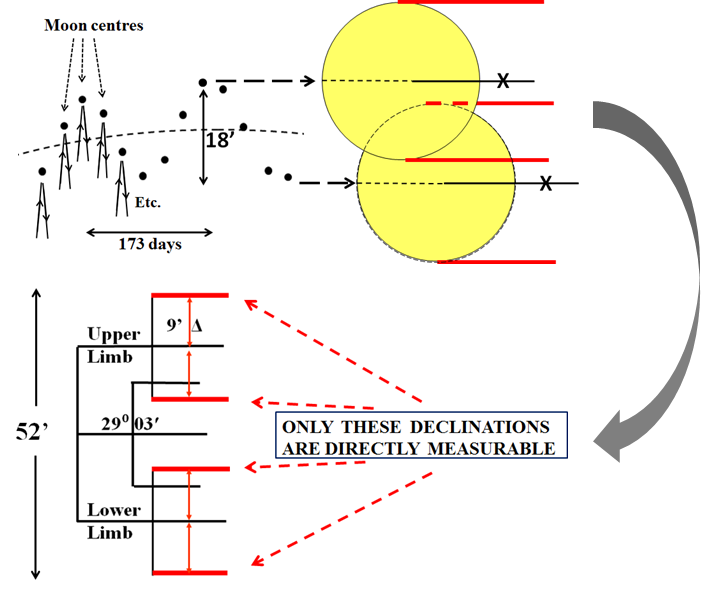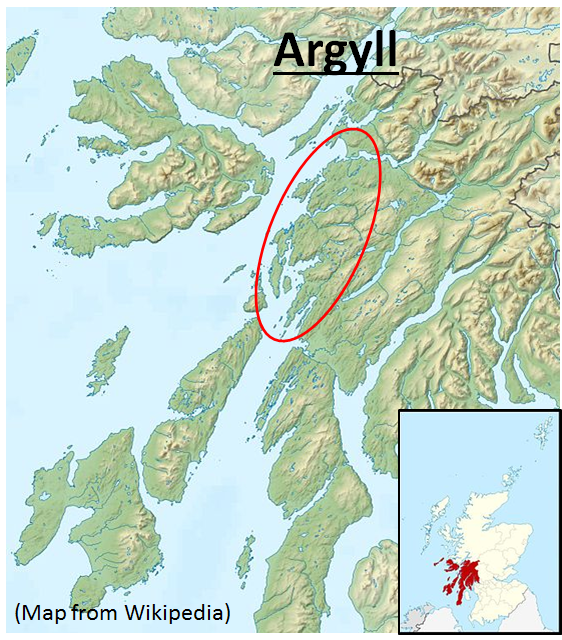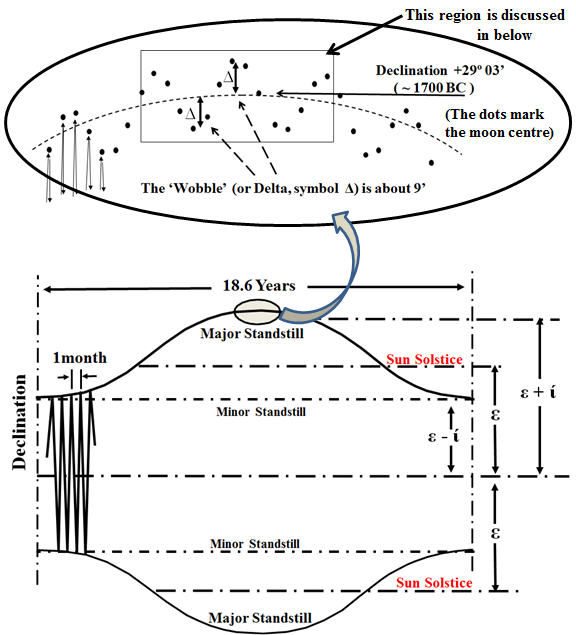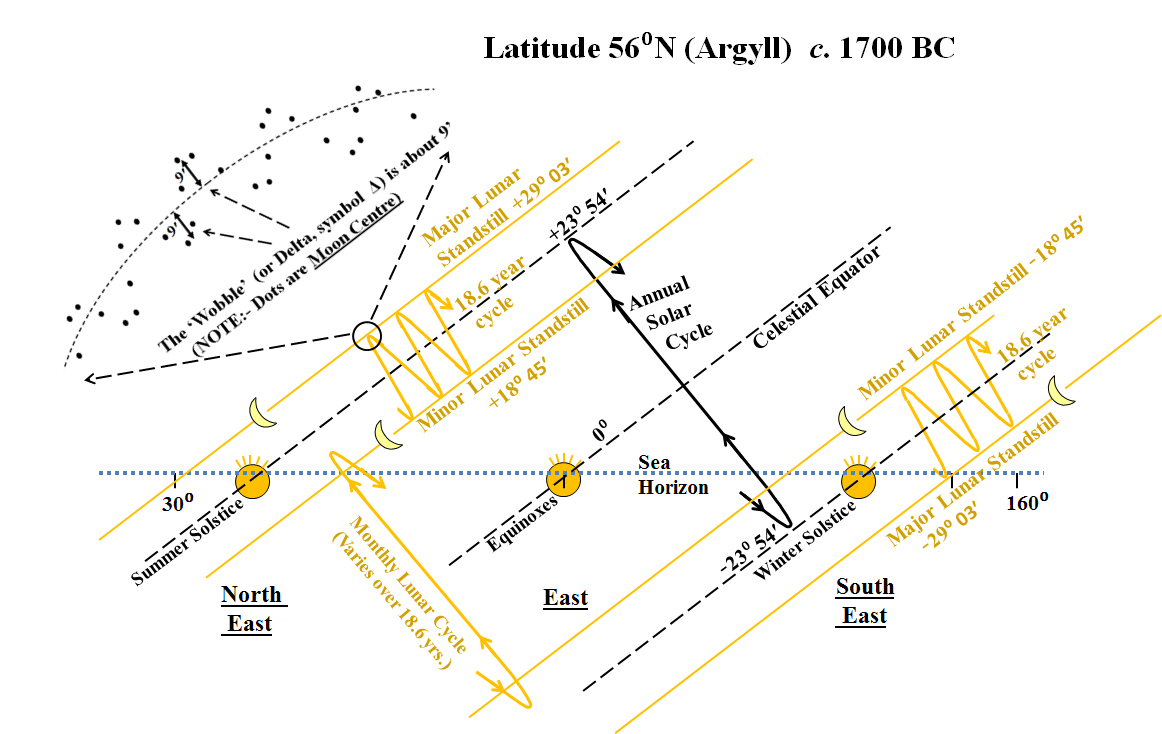New Evidence for Precise Lunar Alignments in Early Bronze Age Scotland
During the 1970s Alexander Thom showed the possible existence of precise lunar alignments using horizon features from a marked backsight . The results were later criticised for their wide choice of site by location and type. By 1985 it was widely accepted that preferential site selection could have caused inadvertent bias. Thus the results could be due simply to chance. The present investigation attempts to avoid these criticisms by choosing a limited region, considering only standing stones (but not circles) and including reports on all sites investigated. Random sites and directions were also investigated in an attempt to determine the likelihood of chance alignments. In the current survey nearly all indicated foresights gave precise lunar alignments the majority giving clear evidence for the observation of the small (9' arc) lunar perturbation ('wobble' ). This knowledge could be used to predict eclipses. These results imply that the currently accepted social structure during the Early Bronze Age requires revision.
In the region shown (mainly part of Argyll in western Scotland), there are 34 sites numbered from north to south. Trees, buildings, and/or fallen stones prevented measurements at 11 sites. The remaining 23 were fully assessed in this study. (See Full list of 34 stones in region examined )
(Thom assessed fully only two (# 20, 21) See Note below. Thom assessed several sites as solstitial (e.g. Kintraw, Ballochroy. See Thom MLO Chap.4 ) and from these determined a value for the obliquity of the ecliptic (ε). This changes slowly with time. The value found corresponds to about 1700BC. Combined with ί (the inclination (ί , about 5° 8′.7) of the moon's orbit to the ecliptic) this gives a maximum lunar declination (i.e. ± (ε + ί ) ) of ±29°03’.0 and minimum (i.e. ± (ε - ί ) ) of ± 18° 45’.6. (Lunar parallax applied). The inclination of the moons’ orbit to the ecliptic results in a small perturbation or ‘wobble’ ( Δ ) of about 9’ arc and period 173 days. (See below for diagrams and Description of the Moon for a further information)
Lunar Band
The moon’s orbit and its apparent movement as seen from earth is not simple. A detailed explanation is available elsewhere (Thom 1971: 15-27; Wood 1978: 66-70; Thom A.S. 1981: North 1996: 553-68). Suffice to say here that the declination of the moon at a lunation maximum varies over an 18.6 year period between ±29° 03ʹ and ±18° 45ʹ c. 1700BC. Also the moon does not come smoothly to the maximum (‘major standstill’) and minimum (‘minor standstill’), but in a series of small waves of amplitude about 9ʹ arc and period about 173 days termed the lunar perturbation or ‘wobble’.
Explanation
An alternative representation of the same information which may be easier to follow:-
(The sun/Moon are shown rising in the North East, East, South East with the sea as the horizon)
.
'
The following diagram illustrates the 'wobble' and introduces the lunar band.

The dots represent the declination of the moon’s centre at each lunation near the major standstill. Note that the only meaningful declinations are for the limbs of the moon with positive or negative ‘wobble’. None of the other possible five declinations (moon centres or limbs of the moon with no ‘wobble’) are unique and/or measurable.
(In the illustration above only the positions of the moon with maximum ± 9ʹ arc ‘wobble’ are shown. For clarity the moon with no ‘wobble’ is omitted - it is not relevant.)
There are 8 lunar bands… rising/setting, north /south, major and minor standstills.
(Note: It is important to have a general understanding of the movements of the moon including the ‘Standstills’ and the ‘Wobble’ and their timescale if the significance of the results presented here are to be appreciated. A detailed understanding of the reasons for the moon’s movements as seen from Earth may be useful but is not necessary.)
An examination of the declination values found resulting from a survey of apparently indicated foresights might be one of the three following possibilities:-
a) The values for lunar declinations at the time of the Maximum Standstill at a given site with an indicated foresight are all or nearly all for one of the values marked in red. i.e. for a limb with 'wobble' Conclusion:- The standing stones were erected for the purpose of indicating foresights and positioned with sufficient precision to enable observation of the finer movements of the moon. i.e. evidence that the 'wobble' was being observed.
b) The declination values described above predominantly fall within the relevant lunar band, but with no particular values being favoured, some fall into the 'gaps' in the lunar band and some are near misses to the band. Conclusion:- The moon was being observed but with no great precision. No evidence that the 'wobble' was being observed.
c) The declination values are completely random both within and without the lunar band apparently indicated. Conclusion:- The 'alignment' is pure chance. The stones were erected for some other unknown purpose not associated with lunar observation.
Comments:-
1) The present generally accepted view, based mainly on Clive Ruggles assessment of Alexander Thom's work (see 'History' below), is that b) is considered to be correct. However the evidence presented here strongly suggests that in fact a) is correct.
2) It seems that since the 1980's, no-one has carried out any further systematic investigation.
(NOTE: History credits the discovery of the ‘wobble’ to the Danish astronomer Tycho Brahe in or about 1595, though there is some evidence that Arab astronomers around 1000AD suspected it. However there is significant evidence that it was known about and observed in the Early Bronze Age.)


